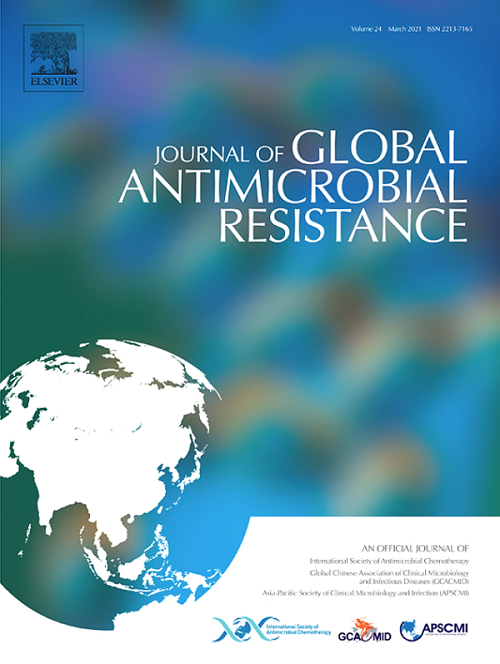Salmonella Minnesota sequence type 548 harbouring a type 2 IncC megaplasmid of antimicrobial resistance and virulence (pESM) infecting a companion animal
IF 3.2
3区 医学
Q2 INFECTIOUS DISEASES
引用次数: 0
Abstract
Objectives
This study reports the identification and genomic characteristics of Salmonella strains isolated from a blood sample of a 9-year-old male Persian cat with a systemic infection (strain M885) and from a pleural effusion sample of a 9-year-old male Bulldog (strain T886) in Brazil.
Methods
Genomic DNA was sequenced using the Illumina NextSeq platform, de novo assembled by SPAdes version 3.15.2, and annotated by the RAST server. Serovars, sequence types (STs), antimicrobial resistance genes, plasmid replicons, Salmonella pathogenicity islands, and single nucleotide polymorphism (SNP) analysis were accomplished by bioinformatic tools.
Results
Strains M885 and T886 belonged to the serovars Sandiego (ST126) and Minnesota (ST548), respectively. Strain T886 carried blaCMY-2 and qnrB19 onto IncC2 and Col(pHAD28) plasmids, respectively. The blaCMY-2-bearing IncC2 plasmid also harboured mercury tolerance genes and the yersiniabactin virulence gene cluster, being classified as a type 2 IncC megaplasmid of antimicrobial resistance and virulence (plasmid for emergent S. Minnesota [pESM]). SNP-based analysis revealed clonal relatedness between the T886 strain and a CMY-2-producing S. Minnesota ST548 previously isolated from chicken sausage in Brazil, supporting a common ancestral origin.
Conclusions
This study underscores the importance of monitoring S. enterica as the causative agent of extra-intestinal infections in small animal medicine. Therefore, the transmission dynamics and effective strategies for managing infections produced by multidrug-resistant clones adapted to the human-animal-environmental interface warrant further investigation.
明尼苏达沙门氏菌序列548型,携带2型IncC抗菌素耐药性和毒力(pESM)巨质粒,感染伴侣动物。
目的:本研究报告了从巴西一只患有全身性感染的9岁雄性波斯猫(菌株M885)的血液样本和一只9岁雄性牛头犬(菌株T886)的胸膜液样本中分离出的沙门氏菌的鉴定和基因组特征。方法:基因组DNA测序采用Illumina NextSeq平台,SPAdes v.3.15.2重新组装,RAST服务器进行注释。利用生物信息学工具完成血清型、序列型(ST)、耐药基因、质粒复制子、沙门氏菌致病性岛和单核苷酸多态性(SNP)分析。结果:菌株M885和T886分别属于圣地亚哥(ST126)和明尼苏达(ST548)血清型。菌株T886分别将blaCMY-2和qnrB19携带到IncC2和Col(pHAD28)质粒上。携带blacmy -2的IncC2质粒也含有汞耐受基因和耶尔希尼abactin毒力基因簇,被归类为具有抗菌素耐药性和毒力的2型IncC巨型质粒(pESM,紧急S. Minnesota质粒)。基于snp的分析显示,T886菌株与先前从巴西鸡肉香肠中分离到的产cmy -2的明尼苏达S. ST548具有克隆亲缘关系,支持共同的祖先起源。结论:本研究强调了在小动物医学中监测肠球菌作为肠道外感染病原体的重要性。因此,传播动力学和管理适应人-动物-环境界面的多药耐药克隆产生的感染的有效策略值得进一步研究。
本文章由计算机程序翻译,如有差异,请以英文原文为准。
求助全文
约1分钟内获得全文
求助全文
来源期刊

Journal of global antimicrobial resistance
INFECTIOUS DISEASES-PHARMACOLOGY & PHARMACY
CiteScore
8.70
自引率
2.20%
发文量
285
审稿时长
34 weeks
期刊介绍:
The Journal of Global Antimicrobial Resistance (JGAR) is a quarterly online journal run by an international Editorial Board that focuses on the global spread of antibiotic-resistant microbes.
JGAR is a dedicated journal for all professionals working in research, health care, the environment and animal infection control, aiming to track the resistance threat worldwide and provides a single voice devoted to antimicrobial resistance (AMR).
Featuring peer-reviewed and up to date research articles, reviews, short notes and hot topics JGAR covers the key topics related to antibacterial, antiviral, antifungal and antiparasitic resistance.
 求助内容:
求助内容: 应助结果提醒方式:
应助结果提醒方式:


